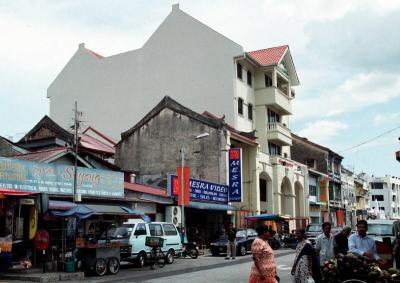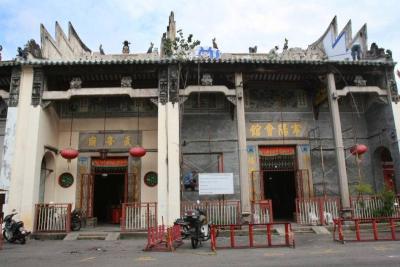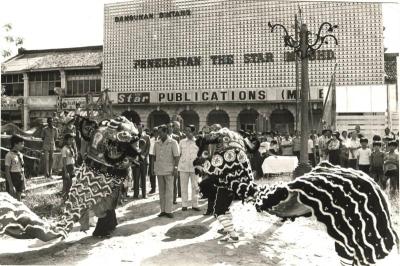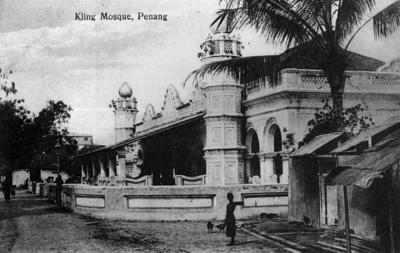 Vibrant: King’s Street is home to Penang’s Little India.
Vibrant: King’s Street is home to Penang’s Little India. FATE works in mysterious ways. I joined The Star as a rookie reporter after finishing Sixth Form in 1980. We were called cub reporters then.
Being accepted into The Star, which had by then emerged as a major player in the English media, was a dream come true as I loved the English language and had a knack for writing.
The salary was paltry and unlike the college students of today, whose parents buy them a car even before they earn their first ringgit, my first mode of transport was the trusty Honda 70 motorcycle, known affectionately by all Penangites as the kapcai. I had to take care of the monthly loan instalments myself.
The Star’s headquarters was a three-storey building in Pitt Street, which has since been renamed Jalan Mesjid Kapitan Keling. It may not be considered big by today’s standards, but it was a grand building with an old-fashioned lift, which was fitted with grilles.
Captain Francis Light named the road Pitt Street after former British Prime Minister William Pitt The Younger. A British politician of the late 18th and early 19th centuries, Pitt became the youngest Prime Minister in 1783 at the age of 24. He left office in 1801 but returned to the post two years later, and died in 1806.
He was known as The Younger to distinguish from his father, William Pitt the Elder, who was also a Prime Minister.
Readers of today who have seen the movie Amazing Grace will get a peek into his life through the story of his friend William Wilberforce, who fought hard to abolish the slave trade in the UK.
Today, as the name denotes, the road has been named after the famous mosque built in the 19th century by Indian Muslim traders in George Town.
 Clan house: The Toi Shan building in King’s Street, Penang. The temple (left) and ancestral hall (right) underwent renovation works.
Clan house: The Toi Shan building in King’s Street, Penang. The temple (left) and ancestral hall (right) underwent renovation works. The Star’s smoke-filled newsroom then, filled with the clickety-clack sound of the typewriters — almost an antique machine now — was intoxicating for me. I fell in love with the place.
I was interviewed by the chief editor H’ng Hung Yong, who had degrees in law and political from Oxford and Harvard respectively. A scholar and an intellectual, he was certainly the man who turned The Star from a regional newspaper into a mass-circulation national daily.
The other iconic figure who was at the same interview was the late Khor Cheang Kee, whose son Martin Khor, continues to write a weekly column in The Star each Monday.
There were other interesting figures. The late Oh Kee Tiang, a bald-headed news editor cut a frightening figure as he would throw a badly-written news report at the offending reporter. He was the huge-sized discipline master, with the rotan, we all remembered as students then.
Then, there was chief reporter Anna Cheah, who was my idea of the hard-nosed reporter, as portrayed in the comic character Brenda Starr.
Anna was a striking figure, in fact, a leggy head-turner, who seemed to know everyone in town. But she was loud, chain smokes and someone you do not want to mess with.
But I was drawn into The Star building, certainly one of the most stately buildings in Penang, in many ways. It had a history of being a kind of opium and liquor distribution centre.
It was, for some strange reasons, known as the Opium and Spirit Farm Offices, which was in charge of a system of government tenders for a variety of enterprises from gambling to tobacco.
The British colonial government had the monopoly of this trade by controlling, regulating and “privatising” it to the highest bidder.
 Stronghold: The Star’s office in Pitt Street in 1974.
Stronghold: The Star’s office in Pitt Street in 1974. It was such a lucrative business that the trade raised half of the total annual revenue of the Straits Settlement government, according to Khoo Salma Nasution.
“The holders of the lucrative monopoly in turn farmed out licences for the preparation and sale of opium to sub-contractors, who then retailed the product at two to three times the cost of the raw Indian import. From these enormous profits, the ‘farmer’ had to provide the preventive measures against smuggling and illegal distribution,” she wrote.
Members of the syndicate extended their prosperity through inter-marriage, in an era when multiple wives and broods of children allowed ample opportunities for the elite families to be united, she added.
This building was built in 1906 at a cost of 48,767 Straits Dollars and rented out to the contractors for 900 Straits Dollars a month.
“It served as a godown and dispensary for candu or cooked opium and samsu, an alcohol distilled from rice and sugar, “ wrote Khoo, but by then the anti-opium movement also gained more support from the public.
In the 1970s, The Star building was also used by the late tycoon Loh Boon Siew as a Honda showroom. In fact, it was the first Malaysian Honda showroom in the country.
He had noticed the popularity of the Honda Super Cub motorcycles on a trip to Japan and quickly convinced its creator Soichiro Honda to market the motorcycles in Malaysia. Boon Siew was appointed the sole distributor and he brought in the first 50 units, according to reports.
The late tycoon went on to play a role in the development of The Star when he came in as a shareholder.
As fate would have it, I was born just behind The Star building at King’s Street or Penang’s Little India. The address on my birth certificate, which stated “89, King’s Street” no longer exists, but there are still older residents who recalled a midwife’s clinic along the road.
 Still standing: Jalan Mesjid Kapitan Keling is named after the Kapitan Keling Mosque. This pictures shows the landmark before it was restored.
Still standing: Jalan Mesjid Kapitan Keling is named after the Kapitan Keling Mosque. This pictures shows the landmark before it was restored. King’s Street was at one time called “The Street of Boatmen” by the Indians because southern Indian Muslim sailors and stevendores were said to live along the road, although there are also many Chinese clan association buildings representing the Hakka, Hokkien and Cantonese.
Of interest is the Wu Ti Meow temple of the Toi San association, which to dedicated to Guan Gong, a war general from the epic Romance of The Three Kingdoms.
“The signboard over the temple entrance was written by Leong Ting Fen, a central government officer in China, who worked as a teacher and calligrapher while in exile in the 1890s for criticising the Prime Minister.
“After the Boxer Rebellion, he regained imperial favour with the Empress Dowager and was appointed a tutor to Puyi, the last emperor of China,” according to Khoo Salma’s book Streets of George Town.
Six months after I began work as a reporter, I had to resign to enrol at the Universiti Kebangsaan Malaysia to study political science and history, but my heart never left The Star.
A day after I finished my final paper in 1984, I rejoined the newspaper at Pitt Street, where Ng Poh Tip was then the Penang editor. “Miss Ng” as I called her then, and even now, was a respectable journalist who had just returned from a stint at Hong Kong’s South China Morning Post.
It was clear even back then that Ng, who has a Masters degree in political science, was being groomed for a bigger role and she rose to become the first woman Group Chief Editor (GCE) in The Star. She is a kind-hearted woman who cut a matron-like figure, and she accepted me back into The Star without even a formal interview.
Lucky for me, both H’ng and Ng were former students of St Xavier’s Institution, and certainly the old students’ network, which seemed vital at that time, must have helped.
Interestingly enough, after Ng, two Xaverians — Datuk Wong Sulong and Michael Aeria — occupied the GCE position until I formally took over in 2008.
I met many interesting people as colleagues and interns during my six years in Penang, and one of them was Khoo Salma who joined the newspaper as a reporter. She went on to become an author and publisher of books about Penang’s history, which is why she has become an important source of information for this column.
Betty Chew, the wife of Penang Chief Minister Lim Guan Eng, was also an intern at the Penang office as a student from Universiti Sains Malaysia.
Betty also did an internship at the Malacca office of Utusan Malaysia. As fate would have it, she would hang out at The Star’s Malacca office which was nearby to the State government buildings. It was in that office that our then Malacca bureau chief M. Veera Pandiyan introduced her to Guan Eng, who was also a regular visitor to office.
My life at the original The Star building ended in 1990 when I was summoned by the national news editor Nizam Mohamed to help in the coverage of the Commonwealth Heads of Government Meeting in Kuala Lumpur.
The main office of The Star had shifted to KL by then. I asked Nizam which hotel I would be staying in while I was in KL, but he was evasive and non-commital.
As it turned out, when I reported to him in KL, he handed me a letter stating that I had been transferred with immediate effect.
There was no mention of a pay rise to meet the cost of living in a city nor was there was even a transfer allowance to help me settle down. But I am certainly where I am now because of this interesting twist of fate.
The Star’s building in Jalan Mesjid Kapitan Keling has continued to live on. Last year, as the newspaper celebrated its 40th anniversary, the pre-war building was given a new lease of life. Beautifully renovated, it is now set to be the home of the Penang Phiharmonic Orchestra.
The Star’s Penang headquarters is now at Bayan Lepas but we continue to maintain a city office on the ground floor while the orchestra will have free use of the top floor for five years.
It has been about 29 years since I became part of The Star family but it will be the early years in the Penang office, where it all began, that will have a lasting memory for me.





